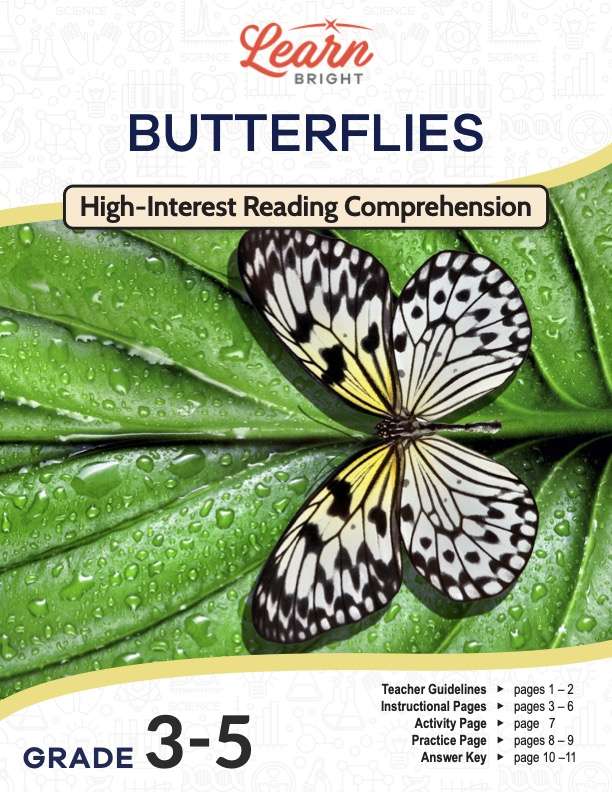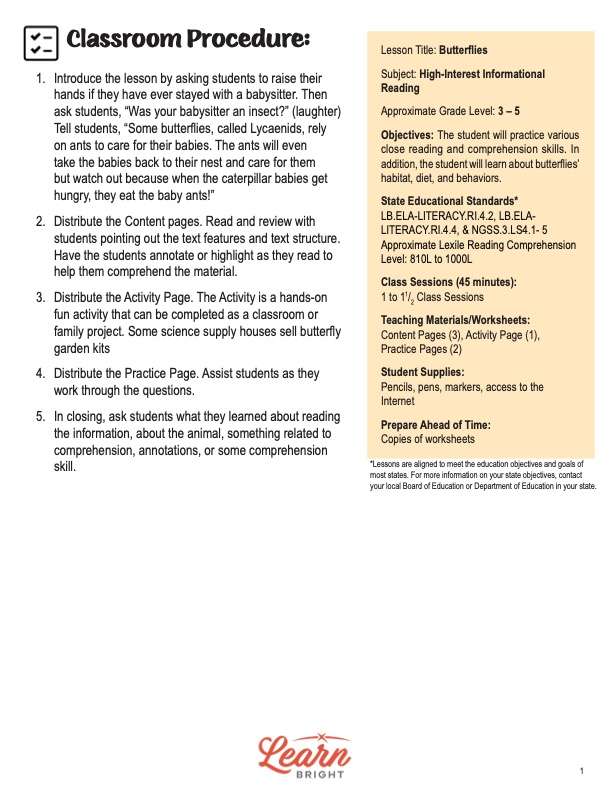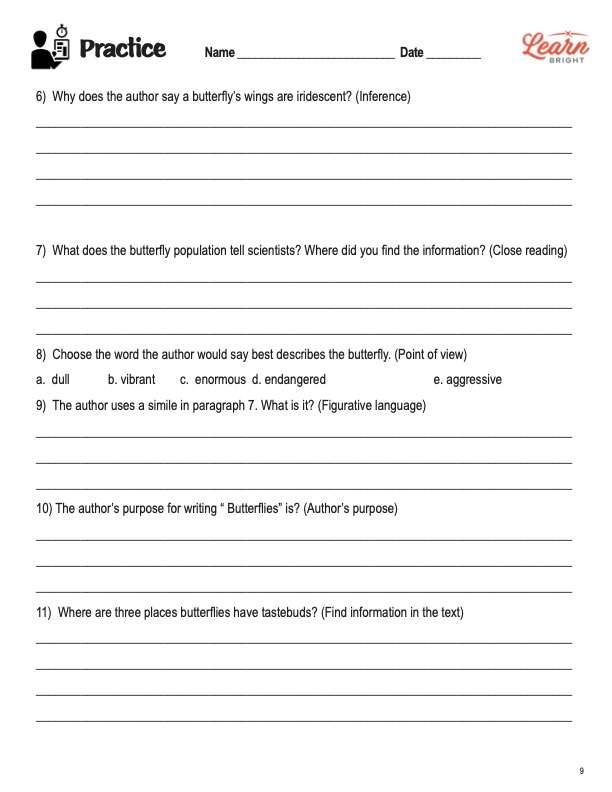Description
What our Butterflies lesson plan includes
Lesson Objectives and Overview: Butterflies is a high-interest reading comprehension lesson plan. As such, students will practice various close reading and comprehension skills. In addition, they will learn about the habitat, diet, and behaviors of a butterfly. This lesson is for students in 3rd grade, 4th grade, and 5th grade.
Classroom Procedure
Every lesson plan provides you with a classroom procedure page that outlines a step-by-step guide to follow. You do not have to follow the guide exactly. The guide helps you organize the lesson and details when to hand out worksheets. It also lists information in the yellow box that you might find useful. You will find the lesson objectives, state standards, and number of class sessions the lesson should take to complete in this area. In addition, it describes the supplies you will need as well as what and how you need to prepare beforehand.
Teacher Notes
The teacher notes page provides an extra paragraph of information to help guide the lesson and remind you what to focus on. It explains that you can teach this lesson in a whole-class setting or to an independent, small group as an activity. The blank lines on this page are available for you to write out thoughts and ideas you have as you prepare the lesson.
BUTTERFLIES LESSON PLAN CONTENT PAGES
What Are Butterflies?
The Butterflies lesson plan contains four content pages. To start off, it provides a small box with basic background information about butterflies. These insects primarily eat nectar and live only for a month. There are over 20,000 species of butterfly that live on every continent except for Antarctica. This is because they are cold-blooded. Their bodies won’t work correctly when below 55°F (13°C).
So instead, most butterflies live in tropical rainforests with many bright, beautiful flowers from which they eat the nectar. Because a butterfly is an insect, it has three body parts: a head, a thorax, and an abdomen. Butterflies also have six legs. But they also have a feature that some other insects lack—wings!
There are four stages in the life cycle of a butterfly. First, the female butterfly lays eggs on a plant. This is where a new butterfly will start its new life. The egg is generally round or oblong—shaped like an oval—and sometimes has ridges. Second, the egg hatches into a caterpillar called a larva. Caterpillars will have fascinating patterns or stripes on their bodies. They have to eat a lot of food to grow, so they start with the plant they hatched on. They grow so big from eating that they shed their skin four times before fully developing and moving into the third stage.
In the next stage, the caterpillar is fully grown and forms a cocoon, becoming a chrysalis. This allows the caterpillar to hibernate and transform into a butterfly. Next, the caterpillar’s tissues are broken down, and butterfly parts form. During the fourth stage, the chrysalis opens to reveal a colorful butterfly. When the butterfly emerges from the chrysalis, its wings are soft and folded into its body. The butterfly takes about three or four hours to learn to fly.
Pigmentation of Butterflies
Butterflies have two types of color. Pigmented color comes from chemicals that absorb and reflect light. For example, if a butterfly’s wings absorb red and blue light but reflect the green light, you will see green on the butterfly. Structural color comes from the structure of a butterfly’s wings. The wings have layers of a see-through material called chitin, and they have thousands of tiny scales that reflect the light.
When the light shines through the scales, the color images become more or less intense. In addition, the structure makes the color shift and change as the butterfly moves. We call this phenomenon iridescence. Iridescence is when the color of something changes as the observer moves.
Students will discover that butterflies’ colors help them attract mates, act as warning signals for predators, and can provide a protective camouflage to help them hide. Some butterfly wings have ultraviolet patterns that humans cannot see. Still, other butterflies can see the patterns and use them to distinguish or tell the difference between mates.
Butterfly Diet and Interesting Facts
Because caterpillars need the correct vitamins and minerals to grow, they only eat leaves from certain kinds of plants. But once they have transformed into a butterfly, they drink nectar from flowers. Butterflies can also drink water and fruit juice or get food from tree sap. They also eat dead and rotting animal matter or other material found in the wild. Finally, butterflies drink from mud puddles to balance out all the sweet nectar they eat. This helps them get the necessary minerals and salt they need to live.
How do they do it? A butterfly drinks from a flower or rotting fruit using a long tongue called a proboscis. The proboscis enables them to suck up all the nectar from a flower. You can think of it like a straw. Butterflies live on liquid because it would be hard to consume solid substances with their proboscis.
Students will then learn some interesting facts about these beautiful critters. In the first life cycle stage, female butterflies lay an egg on a plant leaf. But to help the eggs stay on the leaf and not roll off onto the ground, they attach them using a special type of glue. Humans have tastebuds on their tongue that help us decide if something is sweet, salty, bitter, or sour. But butterflies have few tastebuds on their proboscis. They also have some tastebuds on their antenna. Yet the majority of their tastebuds are on their feet!
Important to the Environment
Butterflies are fun to watch, and they are essential for the environment. They—along with bees, moths, birds, and bats—pollinate over 75% of the world’s flowering plants. We depend on pollinators to help plants reproduce, strengthening the ecosystems by creating more biological diversity in nature. In addition, research into the size of butterfly populations lets scientists know whether the ecosystem is stable or unbalanced.
Butterflies are also an essential part of the food chain. They exist in large numbers during certain times of the year, providing food for birds, small mammals, and other insects. But butterflies are not just prey. They are also predators. Butterflies can eat aphids, which helps control the population of these pests.
Finally, students will learn that like many other species, butterflies struggle with habitat loss. Much of their habitat has been lost to agriculture, urban development, and the tearing up land to find natural resources for humans. The small spaces left often do not provide enough food, shelter, or safety necessary to survive. Butterflies also struggle with climate change. Cues from the environment tell the eggs when to hatch, and unpredictable temperatures lead to unpredictable hatching times. If the eggs hatch too early, it could be disastrous for the caterpillar.
BUTTERFLIES LESSON PLAN WORKSHEETS
The Butterflies lesson plan includes two worksheets: an activity worksheet and a practice worksheet. Each one will help students solidify their grasp of the material they learned throughout the lesson. You can refer to the classroom procedure guidelines to know when to hand out each worksheet.
BUTTERFLY GARDEN ACTIVITY WORKSHEET
Students will divide into teams for the activity. Each team will design a butterfly garden for their community, home, or school. They will need to research, think about, and answer a series of questions related to their garden. Details they will need include shape and size (with measurements), types of flowers and plants, and butterfly species. Students must also consider things like who will be in charge of tending the garden and the rules people would have to follow.
CONTENT REVIEW PRACTICE WORKSHEET
The practice worksheet lists 11 questions based on the content. You can decide whether or not you allow students to use the content pages or review them prior to the assignment. You could also use this worksheet as a quiz to test their comprehension and retention.
Worksheet Answer Keys
At the end of the lesson plan document is an answer key for the practice worksheet. The correct answers are all in red to make it easier for you to compare them with students’ responses. If you choose to administer the lesson pages to your students via PDF, you will need to save a new file that omits these pages. Otherwise, you can simply print out the applicable pages and keep these as reference for yourself when grading assignments.










